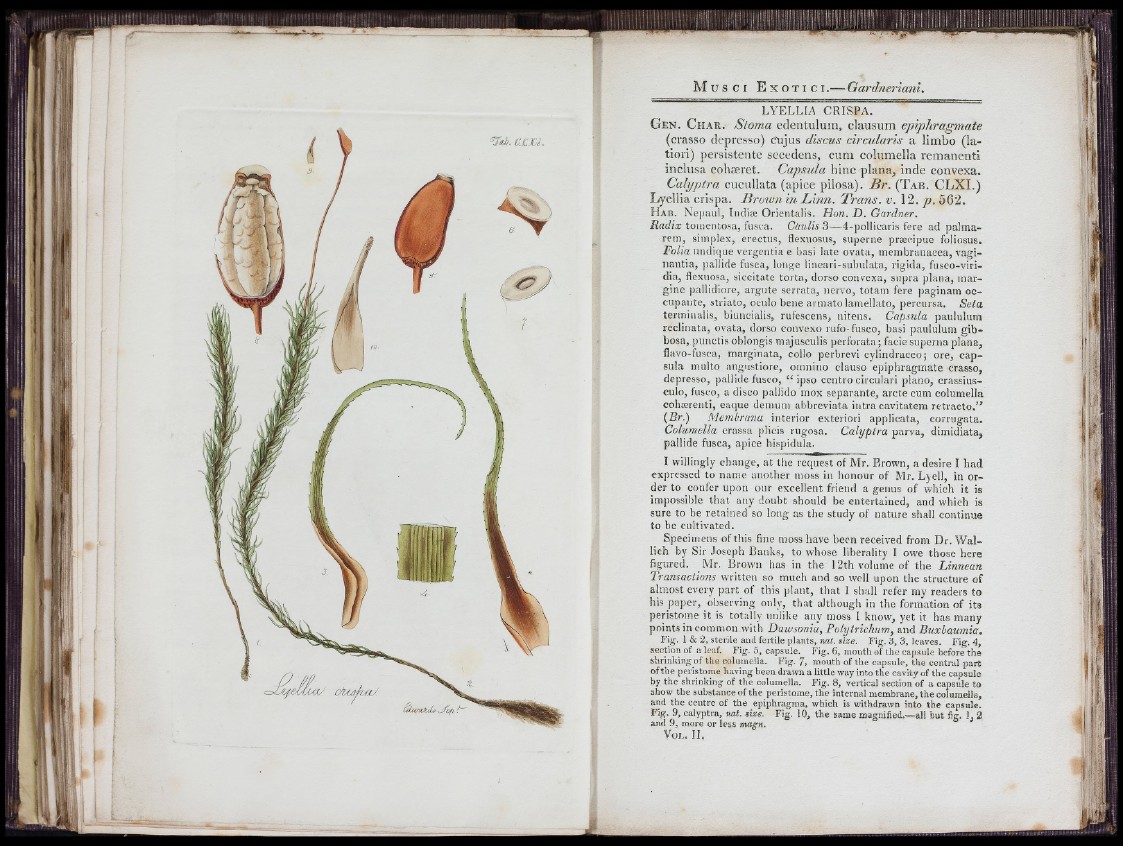
e x z L
LYELLIA CRISPA.
Gen. Char. Stoma edentulum, clausum epiphragmate
(crasso depresso) cujus discus circidaris a limbo (la-
tiori) persistente secedens, cum columella remanenti
inclusa cobæret. Capsula bine plana, inde convexa.
Calyptra cuculiata (apice pilosa). B r. (Tab. CLXI.)
Lyellia crispa. Brutun in Binn. Trans, v. 12. p . 562.
Hab. Nepaul, Indiæ Orientalis. Hon. D. Gardner.
Radix tomentosa, fusca. Cdulis 3—4-polliearis fere ad palma-
rem, simplex, erectus, flexnosns, superne præcipue foliosus,
FoUa undique vergentia e basi late ovata, membranacea, vaginantia,
pallide fusca, longe lineari-subiilata, rigida, fusco-viridia,
flexuosa, siccitate torta, dorso convexa, supra plana, margine
pallidiore, argute serrata, nervo, totam fere paginarn occupante,
striato, ocnio bene armato lamellato, percursa. Seia
terminalis, biuncialis, rufescens, nitens. Capsula paululum
reclinata, ovata, dorso convexo rufo-fusco, basi paululum gibbosa,
punctis oblongis majusculis perforata; facie stipernaplana,
flavo-fusca, marginata, collo perbrevi cylindraceo; ore, capsula
multo angustiore, omnino eiauso epiphragmate crasso,
depresso, pallide fusco, “ ipso centro circular! plano, crassius-
culo, fusco, a disco pallido mox separante, arcte cum columella
cohærenti, eaque demum abbreviata intra cavitatem retracto.”
(Br.) Membrana interior exteriori applicata, corrugata.
Columella crassa plicis rugosa. Calyptra parva, dimidiata,
pallide fusca, apice hispidula.
I willingly change, at the request of Mr. Brown, a desire I had
expressed to name another moss in honour of Mr. Lyell, in order
to confer upon our excellent friend a genus of which it is
impossible that any doubt should be entertained, and which is
sure to be retained so long as the study of nature shall continue
to be cultivated.
Specimens of this fine moss have been received from Dr. Wallich
by Sir .loseph Banks, to whose liberality I owe those here
figured. Mr. Brown has in the 12th volume of the Linnean
Transactions written so much and so well upon the structure of
almost every part of this plant, that I shall refer my readers to
his paper, observing only, that although in the fornration of its
peristome it is totally unlike any moss I know, yet it has many
points in common with Dawsonia, Poly trichum, and Buxbaumia.
F ig . 1 & 2 , s te rile an d fe rtile p la n ts , nat. size. F ig . 3 , 3, le aves. F ig . 4 ,
sec tio n o f a leaf. F ig . 5 , c ap su le. F ig . 6, mo u th of th e cap su le before th e
sh rin iiin g of th e columella. F ig- 7. m o u th of th e c a p su le , th e c e n tra l p a r t
o f th e p e ristom e h av in g b een d rawn a little way into th e cavity of th e cap su le
by th e s h rin k in g of th e columella. F ig . 8 , v e rtic a l sectio n o f a c ap su le to
show th e su b stan c e of th e p e ristom e , th e in te rn a l m em b ran e , th e c o lumella,
an d th e c e n tre of th e ep ip h ragm a , wh ich is w ith d raw n in to th e cap su le .
F ig . 9 , c a ly p tra , n a/. size. F ig , 10, th e sam e magnified.—a ll b u t fig. 1, 2
and 9 , mo re o r le ss magn.
Vol. IL
i n
GAI
1 i Î